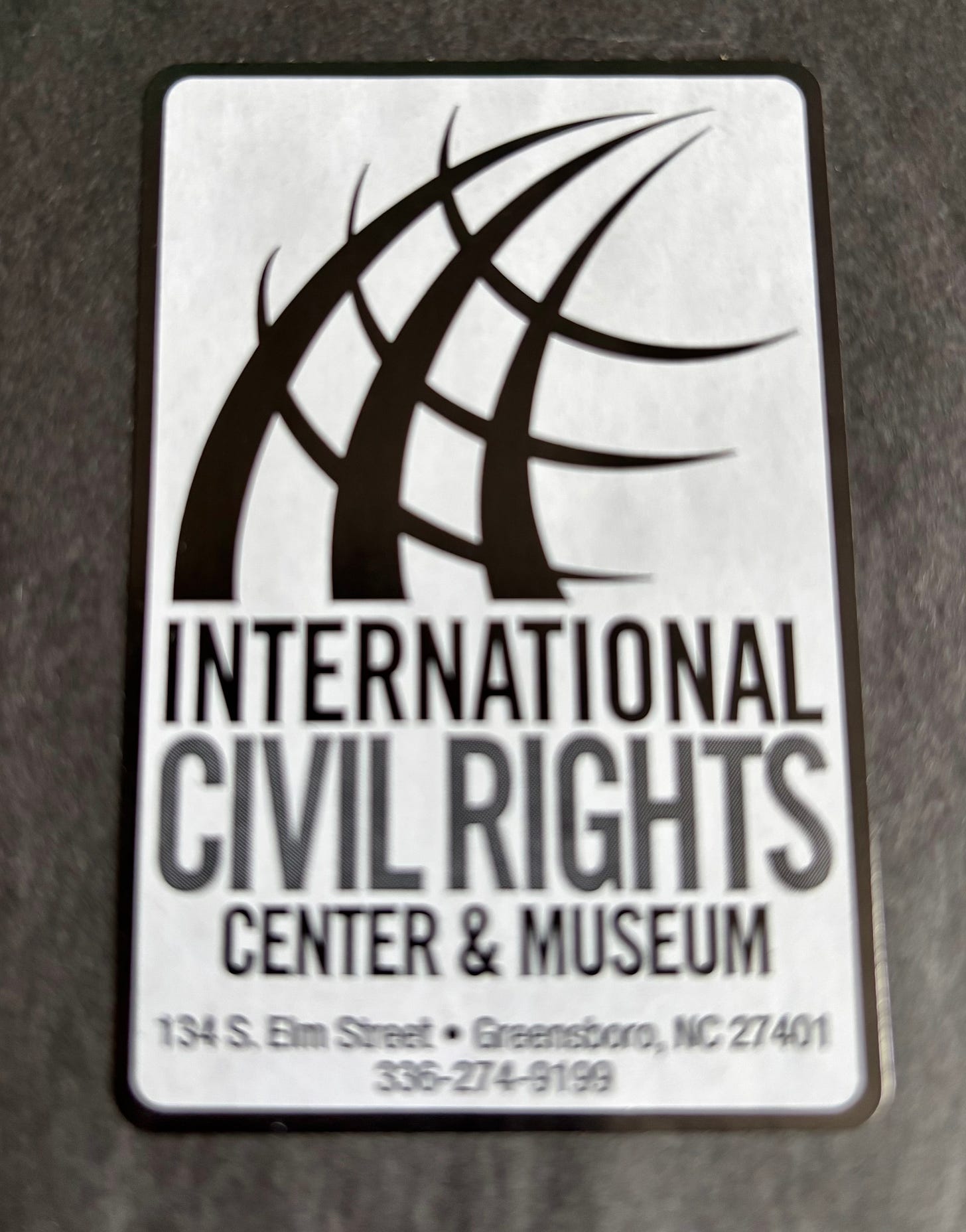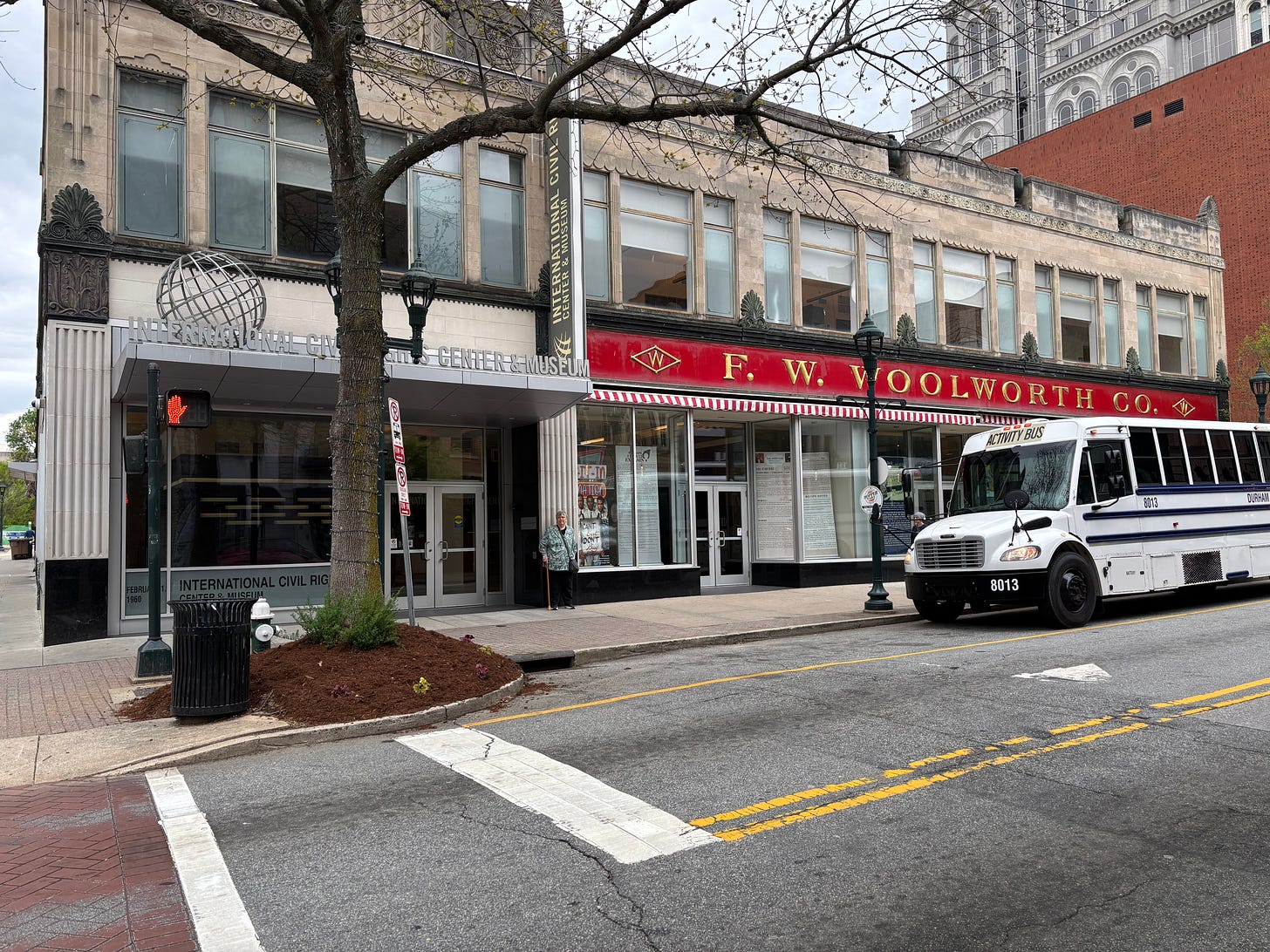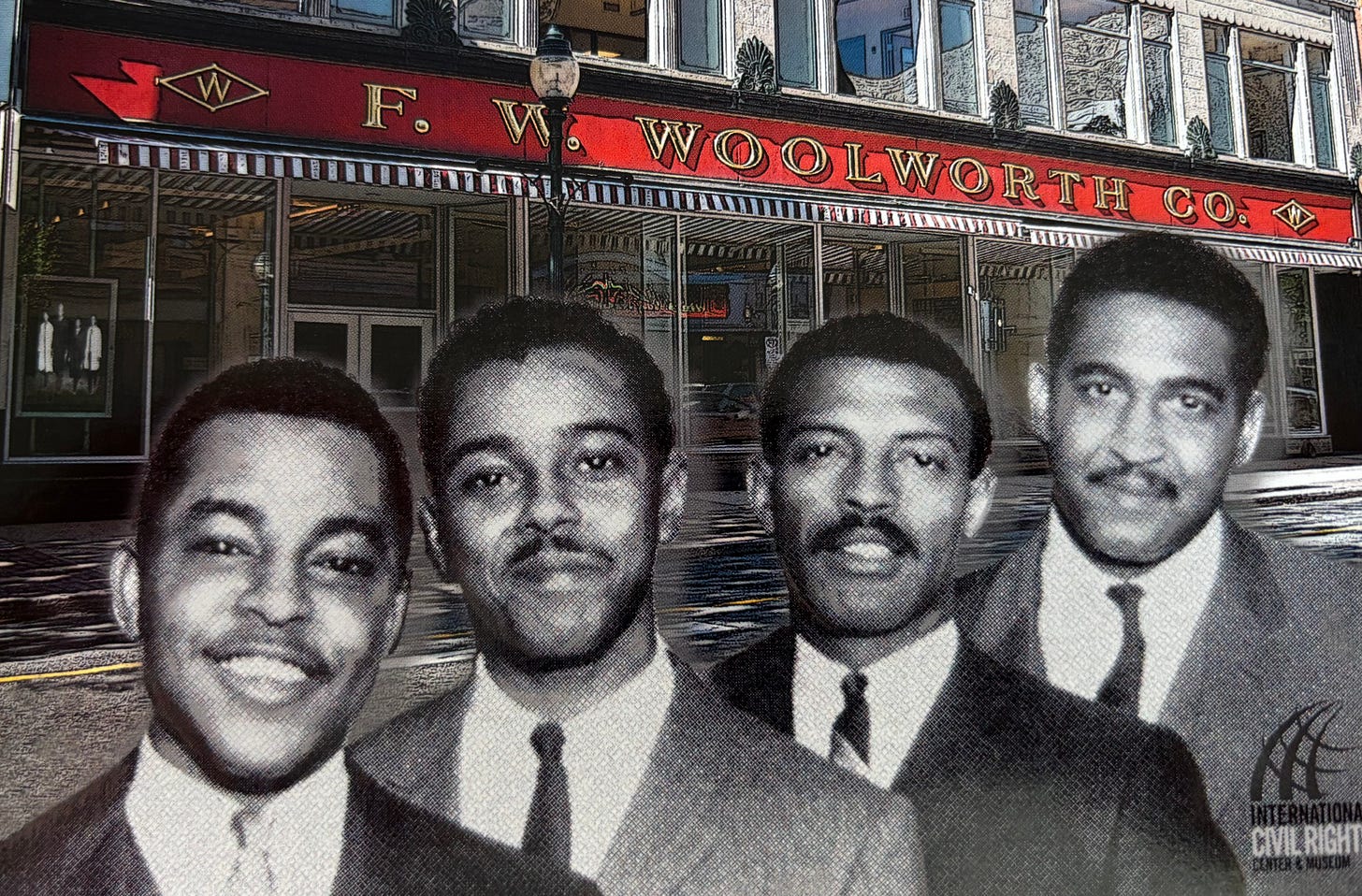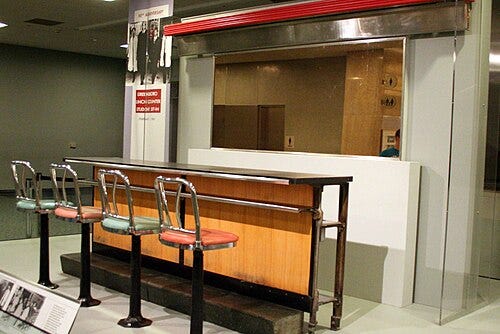The lunch counter
For years I have wanted to visit the International Civil Rights Museum. After all, it is only in Greensboro, North Carolina, not even three hours away from where we live. As part of our 50th Anniversary Trip across North Carolina and back—which my husband labeled as “The Fun, Friends, Food and Family Tour ”—began to take shape, the Museum made it on the list early in the planning.
We arrived at the Museum (which is in the original downtown Greensboro Woolworth’s where the sit-ins occurred) and we found a parking place right on the street about a block away. We had bought our tickets on line as we wanted to go through the Museum with a tour guide instead of just wander through on our own; our Tour Time was set for 11 AM but we were early. We are always early.
Fortunately another tour had just begun and they were able to add us to that group. Our guide was Darren McGill and he was one of the best guides I have ever experienced. He led us through the maze of 13 exhibit galleries and offered thoughtful commentary in each area, always pausing at the end to answer any questions we might have. Every gallery was an education in itself.
Our group consisted of a mother and her young daughter, a group of young black teenage men from a Durham public school and Tom and I. We were the only white people on the tour. Everyone treated everyone else in our group with respect and kindness and I think that was partially because our guide, Mr. McGill set that tone as our guide.
The initial inspiration for the museum happened on February 1, 1960 when four black college students sat down at the whites-only lunch counter at the local Woolworth’s store in Greensboro. They had already done some shopping with the receipts to prove they were customers and then they asked to be served at the lunch counter. The lunch counter staff, some white, some black, nervously refused. Even though many of the staff were black they knew that they were not allowed to serve these four young black men. The store manager was called and he asked them to leave. They refused. The four university freshman stayed at the lunch counter until the store closed.
Those four young men were Ezell Blair, Jr. Joseph McNeil, David Richmond and Franklin McCain. Many have forgotten their names but what they accomplished will not be forgotten. This was not the first sit-in of the civil rights movement but this was instrumental; it was well-organized, non-violent, and involved both black and white protestors. Students, churches, community members and civil rights organizations joined the lunch counter protest. Over 70,000 people participated in the lunch counter sit-in movement which lasted five months, three weeks and three days. These four young men were the catalyst for the Woolworth chain of stores ending their policy of racial segregation in the South.
This event is so significant in the history of the civil rights movement that a portion of the lunch counter was donated and installed at the National Museum of African American History and Culture, part of the Smithsonian Institution in Washington,D.C.
But here is the kicker. A kick in the gut actually. According to today’s substack post by Robert Hubbell, a well-respected writer and policy maker, President Trump has charged Vice President J. D. Vance to vandalize (and yes, that is an accurate choice of words—VANDALIZE) U.S. museums by divesting them of important artifacts of American history. There have been efforts to physically remove the Greensboro, North Carolina, Woolworth’s lunch counter exhibit from the National Museum of African American History and Culture.
We cannot allow our American history to be vandalized and desecrated. We need to pay attention to what is happening in our own cities, in the museums we love, in our libraries and other cultural institutions. This is OUR history; not the white-washed history of a corrupt and racist President and his gang.
We never know when one small action may start a chain reaction that leads to the greater good. Four young college students sitting around a dorm room make a decision that will change the course of history. We, too, have the power to be a spark that changes history.
If you want to be inspired, go visit the International Civil Rights Museum in Greensboro, North Carolina. And if possible, ask for Darren McGill to be your guide.
Please note that no photography is allowed in the International Civil Rights Center and Museum (as is true in many museums) so all the photos I have used in this post are copies of the post cards they sell in their gift shop and others I found permission to use on the internet plus one my husband Tom took with me standing outside the entrance..
PLEASE NOTE: I just found out this information today. I hope this is accurate. I must admit to still being suspicious based on previous actions by Donald Trump. But I hope our museums and other institutions can protect our cultural heritage:
“Recent reports about the Smithsonian removing the historic Greensboro, North Carolina, lunch counter and a stool from the National Museum of American History and National Museum of African American History and Culture, respectively, are inaccurate.
Both the Greensboro lunch counter and stools where college students sat in protest during the Civil Rights Movement are and continue to be on display. A stool from the sit-ins remains on view at the National Museum of African American History and Culture as the centerpiece of an interactive exhibition. The larger section of the Greensboro counter also remains on display at the National Museum of American History. Suggestions that the Smithsonian had planned or intended to remove these items are false.
Further, the Smithsonian routinely returns loaned artifacts per applicable loan agreements and rotates objects on display in accordance with the Smithsonian’s high standards of care and preservation and as part of our regular museum turnover. Recent claims that objects have been removed for reasons other than adherence to standard loan agreements or museum practices are false.
As the steward of our nation’s treasures and history, the Smithsonian preserves and protects all objects and artifacts in its collection to ensure their long-term conservation and to safeguard them for future generations.”







Thank you for reminding me of this museum in Greensboro. We drive through Greensboro many times and the next time (or the next) we will stop and see it. I am glad to know you can buy tickets on line and ask for your tour guide. These men's actions had a profound effect on our country. I only hope our actions today have such an effect to change what is happening to our country at this time.
Thank you Jeanne. I am moved by your reminder of the civil rights movements and how a few humble and brave individuals took such a risk and prevailed. I pray that in these dark times we will all be lifted up through love, strength and forgiveness. 🙏